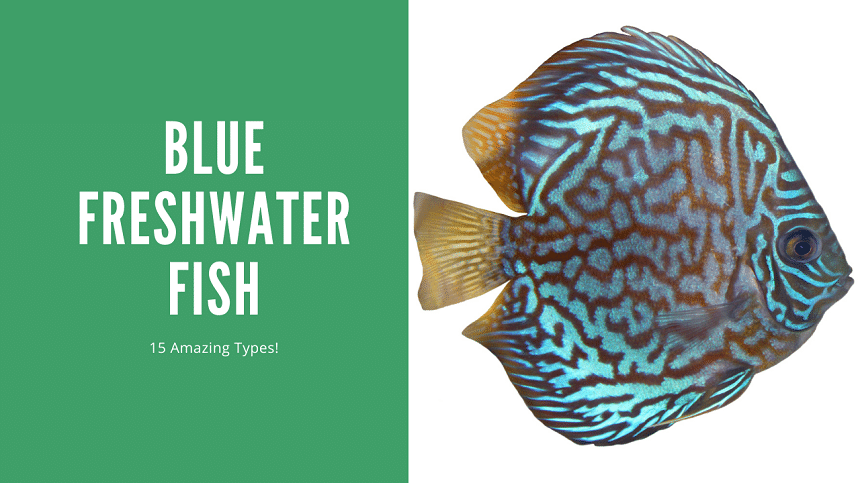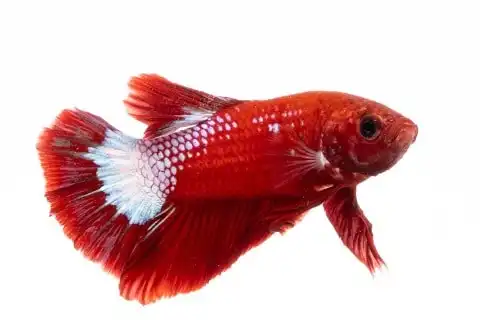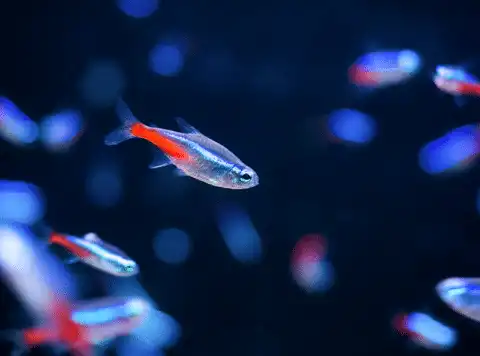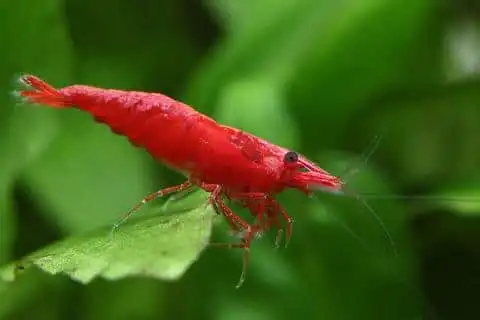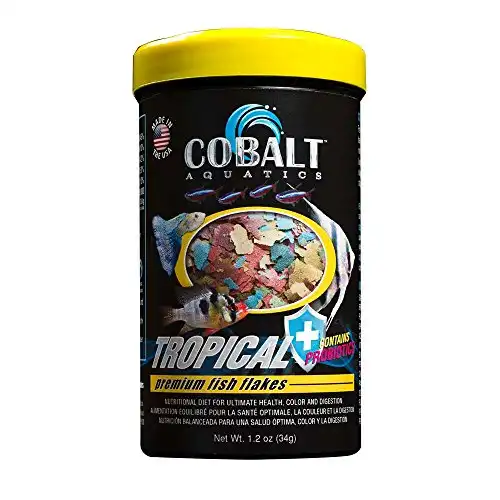Thank you for visiting! By the way… any links on this page that lead to products on Amazon and other stores/partners are affiliate links Aquarium Store Depot earns a commission if you make a purchase.
Do you love blue fish? You may have seen amazing saltwater fish like royal blue tangs and yellowtail blue damselfish, but there are also many amazing freshwater options to choose from! In this article, I’ll introduce 15 amazing blue fish species that you can keep in your own freshwater aquarium, so let’s get started!
15 Best Blue Freshwater Fish Species
Choosing the right aquarium fish involves some careful thought. It’s really important to know how big they grow, how much space they need, and whether they will be happy in the kind of water you have.
To make choosing the perfect bluefish easier, I’ve included the following important stats for each species:
- Scientific Name
- Difficulty Level
- Adult Size
- Temperament
- Origin
- Minimum Tank Size
- Temperature
- Diet
- pH
- Difficulty to breed
- Planted tank suitability
Now you’re ready to meet some awesome bluefish! Check out our video above from our YouTube Channel. We go over more details in the blog post below. If you like our content, be sure to subscribe. We post new videos every week!
1. Betta fish/ Siamese fighting fish
Use Coupon Code ASDFISH at Checkout
Betta Fish are one of the most beautiful varieties of freshwater fish available in the hobby. Easy to care for with plenty of varieties!
- Scientific Name: Betta splendens
- Difficulty Level: Moderate
- Adult Size: 2.5 inches
- Minimum Tank Size: 5 gallons
- Temperature: 75-82°F
- pH: 6.5-7.5
- Temperament: Aggressive
- Origin: Southeast Asia
- Diet: Carnivore
- Difficulty to breed: Moderate
- Planted tank suitability: Yes
Betta fish are one of the best blue fish for fishkeepers who want to keep a nano aquarium. Of course, not all bettas are blue, so you’ll need to shop around for a specimen that suits your taste. These pretty fish come in a huge variety of different fin shapes, and can be found in solid blue, or combinations of colors that include everything from turquoise to deep blue!
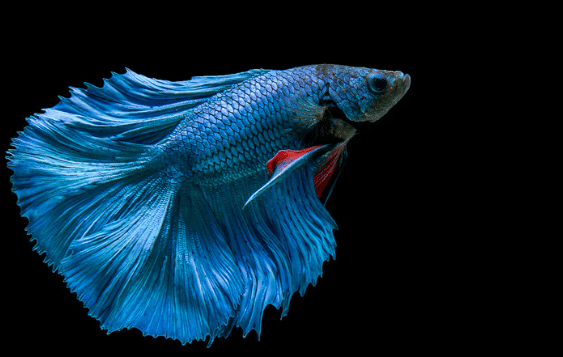
It’s usually best to keep betta fish on their own. Male bettas are very aggressive fish and will fight and kill other male bettas. Female bettas are less aggressive than males but it can still be risky to keep more than one in the same aquarium.
You can keep a betta fish with tank mates in larger tanks. You just have to be careful about what you add as the betta can prey on small inverts and will be nipped by overactive fish.
2. Fancy Guppies
An undemanding fish that is a livebearer. Many varieties available
- Scientific Name: Poecilia reticulata
- Difficulty Level: Easy
- Adult Size: 1.5-2.5 inches
- Minimum Tank Size: 10 gallons
- Temperature: 64-82°F
- pH: 7-8.5
- Temperament: Peaceful
- Origin: Northeastern South America
- Diet: Omnivorous
- Difficulty to breed: Easy
- Planted tank suitability: Yes
Guppies are another hugely popular aquarium fish that come in a range of patterns and colors-including blue! These aquarium fish come in many different shades of blue, including sky and royal blue.
Guppies are peaceful community fish that get along great with other fish. The fancy guppy is a very hardy fish that is easy to care for and will thrive in just about any freshwater tank setup with hard water.
3. Blue Gourami
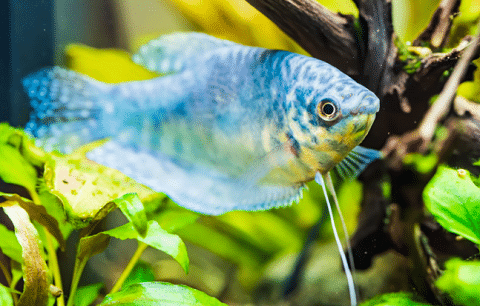
- Scientific Name: Trichopodus trichopterus
- Difficulty Level: Easy
- Adult Size: 5 inches
- Minimum Tank Size: 20 gallons
- Temperature: 75-86°F
- pH: 5.5-8.5
- Temperament: Semi-aggressive
- Origin: Southeast Asia
- Diet: Omnivorous
- Difficulty to breed: Moderate
- Planted tank suitability: Yes
The blue gourami is also known as the three spot gourami. This hardy and easy to care for species is great for fishkeepers who want medium-sized blue aquarium fish.
This gourami species comes in a few different breeds, and not all of them are blue. The best options are the wild 3 spotted form, or even better, the opaline form if you want a really great centerpiece fish.
4. German Blue Rams

- Scientific Name: Mikrogeophagus ramirezi
- Difficulty Level: Moderate/advanced
- Adult Size: 1.5 inches
- Minimum Tank Size: 15 gallons
- Temperature: 80-86°F
- pH: 4-7
- Temperament: Peaceful
- Origin: Venezuela, Colombia
- Diet: Omnivorous
- Difficulty to breed: Moderate
- Planted tank suitability: Yes
The German blue ram is one of my favorite blue fish species. If you’re looking for amazing color, the ‘electric blue’ breed will really impress you!
These gorgeous little cichlids are super peaceful fish and stay very small, unlike most other South American cichlids. Unfortunately, the German blue ram is not great for beginners because they need perfect water quality to stay healthy.
5. Blue Peacock Cichlid
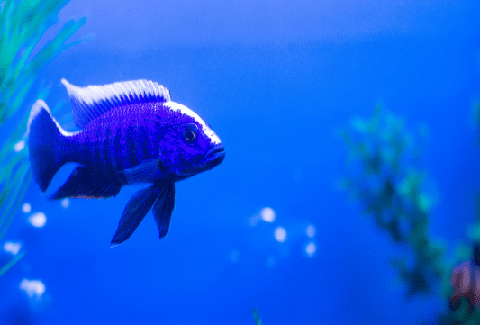
- Scientific Name: Aulonocara nyassae
- Difficulty Level: Moderate
- Adult Size: 7 inches
- Minimum Tank Size: 55 gallons
- Temperature: 76-82°F
- pH: 7.8-8.6
- Temperament: Semi-aggressive
- Origin: Lake Malawi, Africa
- Diet: Carnivorous
- Difficulty to breed: Moderate
- Planted tank suitability: Yes
The blue peacock cichlid is an awesome blue fish from Lake Malawi in Africa. Like most other African cichlids, these fish need high pH water to thrive. These fish are classified as semi-aggressive and become pretty aggressive when breeding, a time when they are their most colorful!
It is best to keep the blue peacock cichlid fish in a group of 1 male and 3 or 4 females to prevent fighting. They are not your typical community fish, and the best tank mates for these fish are other peacock cichlids.
6. Blue Zebra Cichlid

- Scientific Name: Maylandia callainos/ Metriaclima callainos
- Difficulty Level: Moderate
- Adult Size: 6 inches
- Minimum Tank Size: 50 gallons
- Temperature: 76-82°F
- pH: 7.8-8.6
- Temperament: Semi-aggressive
- Origin: Lake Malawi, Africa
- Diet: Herbivore
- Difficulty to breed: Moderate
- Planted tank suitability: Possible
The cobalt blue zebra cichlid is an mbuna cichlid. These fish are known for being quite aggressive if not kept with the right tankmates. It is best to keep one male with 3 or 4 females to limit aggression.
These fish are not suitable for most community aquariums, but they can be amazing in mbuna aquariums with other species of African cichlids.
7. Electric Blue Johanni
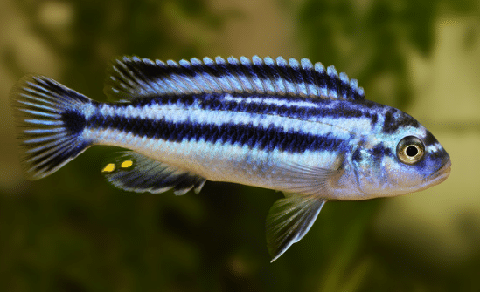
- Scientific Name: Melanochromis johannii
- Difficulty Level: Moderate
- Adult Size: 4-5 inches
- Minimum Tank Size: 40 gallons
- Temperature: 73-81°F
- pH: 7.6-8.8
- Temperament: Semi-aggressive
- Origin: Lake Malawi, Africa
- Diet: Omnivore
- Difficulty to breed: Moderate
- Planted tank suitability: Possible
The electric blue johanni is a great little African cichlid with vibrant blue colors. It is only the males that are dark blue, however, and the females are a beautiful golden orange color. Some of the best tank mates for mbuna cichlids like electric blue johannis are other mbuna cichlids from lake Malawi.
8. Frontosa

- Scientific Name: Cyphotilapia frontosa
- Difficulty Level: Moderate
- Adult Size: 10-12 inches
- Minimum Tank Size: 75 gallons
- Temperature: 72-82°F
- pH: 8-9
- Temperament: Semi-aggressive
- Origin: Lake Tanganyika, Africa
- Diet: Carnivore
- Difficulty to breed: Moderate
- Planted tank suitability: Possible
The frontosa, or humphead cichlid, is a great species for fish keepers who want a large and dramatic display tank! These fish are not pure blue, but rather silvery blue with bold vertical black bars. Although you could keep a frontosa cichlid in a tank as small as 70 gallons, you’ll really want a 180-gallon tank or larger to keep them in a group.
9. Discus Fish

- Scientific Name: Symphysodon aequifasciata
- Difficulty Level: Moderate
- Adult Size: 8 inches
- Minimum Tank Size: 55 gallons
- Temperature: 79-86°F
- pH: 6.1-7.5
- Temperament: Peaceful
- Origin: Brazil
- Diet: Omnivorous
- Difficulty to breed: Moderate
- Planted tank suitability: Yes
Discus fish are one of the most beautiful (and peaceful) cichlids in the hobby. These colorful freshwater fish get their name for their round, disc-shaped bodies.
There are many varieties of discus available, including some amazing blue types like the cobalt, blue snakeskin, and blue diamond discus.
10. Cardinal Tetra
A very popular schooling fish. Looks like the Neon Tetra, but with longer blue and red stripes. Grows larger than a neon tetra as well
- Scientific Name: Paracheirodon axelrodi
- Difficulty Level: Moderate
- Adult Size: 1.5 inches
- Minimum Tank Size: 15 gallons
- Temperature: 73-81°F
- pH: 5.5-7.5
- Temperament: Peaceful
- Origin: Brazil and Venezuela
- Diet: Omnivorous
- Difficulty to breed: Moderate
- Planted tank suitability: Yes
Cardinal tetras are gorgeous fish that have vivid blue stripes that run the length of their bodies from their bright blue eyes almost to the start of their caudal fin. Cardinal tetras look very similar to our next species, the neon tetra, but have more contrast between red and blue.
These peaceful community fish get along great with other smaller fish. They are ideal for a community setup, especially if kept in schools of 8 or more.
11. Neon Tetra
Use Promo Code ASDFLIPPROMO
One of the most popular freshwater community schooling fish available in the aquarium trade. Great neon blue colors!
- Scientific Name: Paracheirodon innesi
- Difficulty Level: Easy
- Adult Size: 1.25 inch
- Minimum Tank Size: 15 gallons
- Temperature: 70-77°F
- pH: 5-7
- Temperament: Peaceful
- Origin: Brazil, Colombia, Peru
- Diet: Omnivorous
- Difficulty to breed: Moderate
- Planted tank suitability: Yes
Neon tetras are amazing blue schooling fish with bright blue stripes along their sides. These colorful freshwater fish are similar to cardinal tetras but slightly smaller and do not have as much red color.
Neon tetras are very peaceful fish that get along great with other peaceful tank mates. Like other tetras, these fish should be kept in groups of 8 or more to see them school and behave confidently.
12. Blue Glofish

- Scientific Name: Various
- Difficulty Level: Easy-moderate
- Adult Size: 2 inches for danios and tetras, 6 inches for sharks
- Minimum Tank Size: 15 gallons for danios and tetras, 55 gallons for sharks
- Temperature: 70-75°F
- pH: 7-8
- Temperament: Peaceful/ semi-aggressive
- Origin: Tank bred
- Diet: Omnivorous
- Difficulty to breed: Moderate
- Planted tank suitability: Yes
Glofish are some of the most colorful freshwater fish in the aquarium hobby. These fish are genetically modified to show the most amazing vivid color. The cosmic blue tetras, (also available in the longfin variety), cosmic blue danios, and cosmic blue sharks are awesome blue fish for freshwater aquariums.
The tetras and danios are very peaceful schooling fish for an awesome freshwater community tank. They grow to just 2 inches or so in length and should be kept in schools of 6 or more. The cosmic blue sharks are larger fish that are classified as semi-aggressive.
13. Praecox Rainbowfish (Dwarf Neon Rainbowfish)
A colorful rainbowfish that only grows up to 3 inches in length. Best in groups of 8 to 10
- Scientific Name: Melanotaenia praecox
- Difficulty Level: Easy
- Adult Size: 3 inches
- Minimum Tank Size: 15 gallons
- Temperature: 73-82°F
- pH: 6.8-7.5
- Temperament: Peaceful
- Origin: Indonesia
- Diet: Omnivorous
- Difficulty to breed: Moderate
- Planted tank suitability: Yes
The praecox rainbowfish is a beautiful blue fish with red fins and a red tail. This colorful fish is also known as the dwarf neon rainbowfish because it maxes out at just 3 inches or so and glows with color in the right lighting.
Praecox rainbowfish are active fish that do great in an aquarium community with other shoaling fish. They are great-looking fish to add as a school in medium to large-sized aquariums.
14. Electric Blue Crayfish
- Scientific Name: Procambarus alleni
- Difficulty Level: Easy
- Adult Size: 4-6 inches
- Minimum Tank Size: 30 gallons
- Temperature: 65-70°F
- pH: 6.5-7.5
- Temperament: Semi-aggressive
- Origin: Southeastern United States
- Diet: Omnivorous
- Difficulty to breed: Moderate
- Planted tank suitability: No
If you’re looking for something a little different for your blue fish aquarium, look no further than the electric blue crayfish (video source)! These awesome critters are native to the United States and they thrive in fish tanks.
Electric blue crayfish are opportunistic feeders that do occasionally catch slow-moving fish. They also love to eat aquarium plants, so they are not ideal for planted tanks. Fast tankmates are recommended, thought not guaranteed that they will not eaten.
15. Freshwater Shrimp
Freshwater aquarium shrimp are a great addition to small tanks and aquascapes. Peaceful, full of personality, and colorful. Many varieties are available.
- Scientific Name: Neocaridina davidi, Caridina cantonensis, Caridina serrata
- Difficulty Level: Easy/moderate
- Adult Size: 0.75-1.5 inches
- Minimum Tank Size: 5 gallons
- Temperature: 72-82°F
- pH: 7-8
- Temperament: Peaceful
- Origin: Southeast Asia
- Diet: Omnivorous
- Difficulty to breed: Easy
- Planted tank suitability: Yes
There are many amazing blue shrimps available in the aquarium hobby. Some great examples include the blue velvet shrimp/ blue dream shrimp (Neocaridina davidi), the blue bolt shrimp (Caridina cantonensis), and the aura blue shrimp (Caridina serrata).

Adult shrimp can be kept with some small community fish, but larger fish will probably see your shrimp as a tasty snack! the great thing about shrimp is that you can keep them in a tank of just 5 gallons or so, making them a perfect choice when you don’t have a lot of room.
Bonus for Freshwater Aquariums
Just in case you’re curious about even more blue fish for freshwater aquariums, here are a few more beautiful fish species to check out!
- Electric blue acara
- Electric blue hap cichlid
- Jewel cichlid
- Blue Jack Dempsey fish
- Green terror cichlids
- Powder blue gourami/ blue dwarf gourami
- Paradise fish
Aquarium Fish Care – The Basics
If you’re new to fish keeping, there are some very important things to know before bringing your new blue fish home. Different fish species have different care needs, but the following tips are a good starting point.
Tank Setup
Setting up a great tank is the first step, and this should always be done before you bring your fish home! In fact, you should set up your tank at least a few weeks before introducing any fish to get it fully cycled and ready.
Read on for a basic list of what you’ll need!
Essential equipment
The most important items you’ll need to set up a great freshwater aquarium for blue fish are:
- Fish tank with a hood/cover- Match the size of the tank to the minimum tank size of the fish you want to keep. Bigger is always better, so go a little larger if you can.
- Filter- A filter is extremely important for keeping your water clean and healthy. Choose a filter that is rated for your tank size or larger.
- Aquarium light- Good lighting will make your fish look really amazing. Set your lights on a timer so that they fire up and switch off at the same time every day. This will give your pets a natural day/night rhythm.
- Heater- Tropical fish need a heater to keep the water temperature stable in their preferred range. Choose a model that matches your tank size.
- Thermometer
These are the basic components of a tropical fish tank. While it is possible to set up a fish tank with just these components, you’ll also want to decorate your tank. Read on to learn more.
Decor
You can get creative or aim to make a really natural-looking environment for your fish. The choice is yours! Whatever you choose to decorate your tank with, however, always make sure it is fish-safe.
Editor's Choice
Manzanita offers it all. Great shape, low tannins, quick to water log and reasonably priced. It's the ultimate driftwood!
Pick up a selection of the following items to make a great home for your blue fish:
- Substrate (gravel/sand)
- Hardscape (Driftwood, lava rocks, etc.)
- Decorations and ornaments
Feeding your fish
Different species of fish have different diets, so make sure to research the needs of your blue fish before picking up some food. Read on to learn some popular aquarium fish food types and how to feed your fish!
Food types
Most popular aquarium fish can be fed a regular diet of prepared dried foods. These come in different shapes and sizes and are designed for different types of fish. Prepared foods can either float or sink.
Here are some common examples of prepared foods:
- Fish flakes
- Pellets
- Granules
- Wafers
- Frozen food
Best Tropical Fish Flake Food
Cobalt offers a premium level flake food with probiotics. A color enhancing formula that works great for all tropical fish
Apart from their regular daily food source, omnivorous and carnivorous fish will benefit hugely from the occasional meal of live or frozen food. These should not be provided every day, but rather as a supplement to improve color and condition. The best choices are:
- Frozen brine shrimp
- Bloodworms
- Blackworms
How much to feed your fish
Overfeeding is very bad for the health of your fish and can lead to poor water quality as uneaten food spoils in the water. Most aquarium fish can be fed once or twice a day when the lights are on. Provide only as much food as the fish can finish in a minute or two.
Maintenance
Keeping your fish tank looking amazing requires you to do some regular aquarium maintenance. You’ll need to clean your aquarium glass with an algae scraper when necessary, and you’ll also need to rinse out your filter if it becomes clogged.
The most important side of maintenance is to perform partial water changes once or twice a month. This will prevent the build-up of harmful chemicals in the water.
Testing
You’ll need a test kit to test your aquarium water quality and find out what your water parameters are. Liquid or strip test kits are really easy to use and very affordable. Use your test kit before adding any fish to your tank and then every week to monitor your water quality.
Choose a test kit that can measure the following parameters:
- pH
- Hardness
- Ammonia
- Nitrite
- Nitrate
Where to Buy
Most of the species on this list can be found at your local fish or pet store. If you can’t find what you’re looking for, you can always order from a trusted online retailer and have your new pets delivered to your home!
FAQS
Are There Any Fish?
Bluefish species are pretty rare in freshwater, but there are some amazing species in the modern aquarium trade. Even common aquarium fish like guppies and betta fish are available in various shades of blue.
What Kind Of Fish Is Bright Blue?
The electric blue german ram cichlid and the cosmic blue glofish tetra are some of the brightest blue fish in the hobby. There are many other bright blue fish, however, so be sure to check out all the species in this article to find your favorite!
Can You Keep This Type of Fish As Pets?
There are many amazing bluefish species that can be kept as pets. These should not be confused with the saltwater fish species that is called a bluefish (Pomatomus saltatrix) of course. That species grows very large and would not make a good pet!
What Is The Name Of A Small Fish?
Fancy guppies, cardinal tetras, and cosmic blue glofish are some great examples of small blue fish. German blue rams are also amazing nano blue fish for more experienced fish keepers.
What Kind Is Tropical And This Color?
There are many amazing blue tropical fish in the aquarium hobby. Neon tetras are a very popular choice for fish keepers looking for a small schooling species, but other fish like discus are also amazing species for a tropical community aquarium.
Final Thoughts
There’s something about blue fish that really makes for a great display tank! With all the great species in this list, there’s a species to suit any aquarist. I hope you found some great ideas for your own tank, and remember, have fun!
Do you keep blue fish in your freshwater tank? Tell us about your favorite species in the comments below!
- About the Author
- Latest Posts
I’m thrilled that you found Aquarium Store Depot! Here you’ll find information on fish, aquariums, and all things aquatics related. I’m a hobbyist (being doing this since I was 11) and here to help other hobbyists thrive with their aquariums! I adhere to a high quality Editorial Process and Review products with real life field usage and practical analysis.

